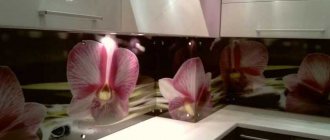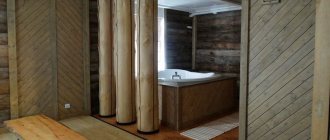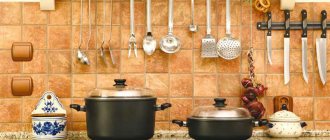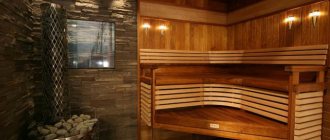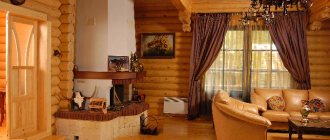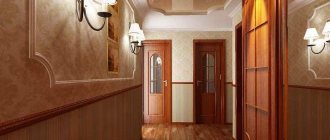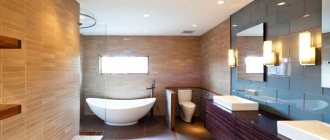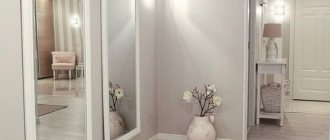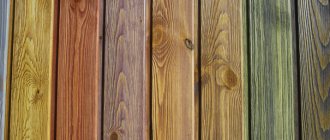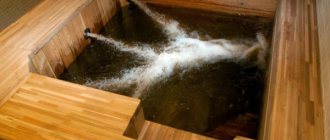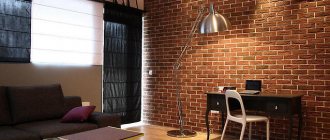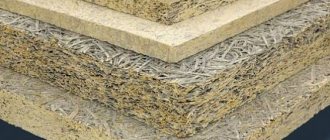What are modern wall panels?
The first thing I would like to start the review with is the variety of wall panels. Their main difference from each other is not at all in size, color or texture, but in the material from which they were made.
Types of wall panels according to the type of material are divided into:
- Natural - solid wood, veneer, glass, stone, plaster, leather, aluminum, etc.
- Artificial - PU (polyurethane), PVC (polyvinyl chloride), plastic, etc.
- Combined - chipboard (chipboard), chipboard (laminated chipboard), MDF (medium density fiberboard), etc.
Wall panels in a loft that is gaining popularity every year will solve a lot of problems
PVC panels in the interior of rooms: installation locations
Polyvinyl chloride panels are vapor-tight, so it is recommended to use them only in the bathroom, kitchen and hallway, balcony and loggia.
Kitchen. The material is well suited as work area aprons due to its moisture resistance, ease of maintenance and variations in decorative design depending on the style of the interior.
Bathroom, toilet. The panels can be mounted on walls, ceilings and decorative screen devices under the sink. PVC in the bathroom is a good choice of finishing due to its ability to not absorb moisture and prevent the formation of mold.
Room design with wall panel
Wall panels in the interior
Balcony, loggia. Well suited for beautifying these premises without high costs. Combined with other types of finishes, with plastic window frames.
Corridor, hallway. It is advisable to use plastic as finishing in these rooms. They are more likely to get dirty, and thanks to PVC, cleaning will be a pleasure.
Modern room design with wall panel
Apartment interior with wall panel
Original room design using wall panels
See alsoFlexible stone in interior design
Gypsum panels
This type of wall panels has not only aesthetic characteristics, but also environmental friendliness. Gypsum-based material has been used since ancient times: simple and complex architectural decorations (bas-reliefs) were made from it. Now it is presented in construction stores in a ready-made format.
The best properties of gypsum panels:
- safe, non-flammable composition that does not release harmful compounds into the environment;
- like ordinary plaster, they can be repainted many times with water-based and other colors;
- are simply mounted (without joints or seams), subject to restoration or individual replacement;
- can provide a large volume thanks to a specially designed design (gypsum 3D panels).
Note! Gypsum panels are able to regulate the humidity in the room, absorbing it or releasing it to the interior decoration.
Gypsum 3D panels on the wall in the form of a custom-made bas-relief will make the project truly exclusive
Accessories for PVC panels
To ensure high-quality installation on the profile, special fastenings are used - decorative molding.
On the one hand, it securely fastens the panels to the wall, and on the other hand, it does not stand out against the general background and serves as an additional design element.
Depending on the installation features, there are the following types of molding:
- external corners
- internal corners
- L-shaped corners (to finish the structure)
- F corners
- ceiling plinth
- connecting H-profile
The relationship between types of fastening and molding is shown in the diagram.
NOTE. When choosing fittings for installation, it is important to pay attention not only to the quality of the product, the correspondence of its grooves to the thickness of the panel, but also to the color - in case of mismatch, the moldings will protrude strongly against the background of the overall surface.
MDF panels
Products, the inside of which is a medium-density fiberboard based on wood chips, and the outside (front) is finished with one of the following materials:
- Laminated film (plain or patterned).
- Highly resistant paint or enamel.
- Veneer of valuable trees.
What are the benefits of MDF panels:
- beautiful - a variety of patterns and colors allows you to add individuality to the room;
- have good moisture resistance, especially if these are special products for wet rooms (bathroom or kitchen);
- impregnated with a special antifungal solution, which increases the useful life;
- have strength comparable to natural wood;
- easy to install thanks to new generation “locks” at the joints.
MDF wall panels with wood imitation on the wall in the living room
Panels or soft panels
Modernity dictates its own rules. Interior designers love to work with soft finishing materials such as faux leather and textiles. Thanks to their colossal variety, the most daring ideas of graphic designers can be realized in an affordable price segment.
The main advantages of soft panels include:
- the possibility of zoning a certain part of the room, for example, near the head of the Geometry bed or as an impact barrier in a children's room.
- with their help you can hide serious wall irregularities: crumbled plaster, joints on drywall, wiring, etc.
- among other things, they have such good properties as additional heat and sound insulation.
- soft polyurethane panels have a great variety of textures that help create an exclusive design project.
Soft wall panels near the head of the bed in the bedroom look very majestic
Types of wall panels
Based on all of the above, we can distinguish several types of wall panels, each of them can be used in different rooms.
First of all, panels can be divided into types based on materials of manufacture. There are several main types:
- Wall panels made from natural materials, most often wooden wall panels in their pure form, will fit perfectly into the interior of a country house and apartments in rustic styles.
- PVC panels are one of the most popular types, since they have a very low cost, and they can be used for finishing any premises, even with high humidity, even with a heavy load, since they are not afraid of water and have high operating loads .
- Vinyl perfectly imitates all kinds of finishing materials such as brick, artificial stone tiles.
- MDF panels are laminated MDF, there are options with a milled pattern. They are well suited for decorating hallways and corridors; they are often combined with wallpaper, when the lower part of the wall is finished with such a panel, and the upper part is covered with wallpaper.
- Decorative panels are made of glass, metal - most often from aluminum and plastic.
Wall panels can also be divided into categories according to format; most often, such finishing options come in narrow and long sheets, their length can be up to 3 meters. There are also sheets of other formats in the form of a large rectangle with an area of up to 3 sq.m. This format is mainly used for decorating the walls of large rooms.
Also, decorative 3D panels have recently appeared, which can have not only different dimensions, but also a different textured volumetric surface.
Polyurethane panels
Very light panels for interior decoration of walls and ceilings. Products made from such material are created with great practicality, and if you do not take into account their unnatural basis, you can find many positive aspects in them.
We list the main advantages of polyurethane panels:
- artificial material can take on various forms, PU is no exception;
- polyurethane itself has poor thermal conductivity, and this is a very good quality for apartments located in cold climates;
- thanks to special developments of the new generation, products are created with certain characteristics necessary for comfortable living, such as resistance to mechanical damage, etc.;
- Low weight allows for quick and easy installation, which even a non-professional can handle.
Advice! Polyurethane panels are perfect for commercial premises such as offices and restaurants, and you can easily attach various decorations or “Wings” panels to them.
Polyurethane wall panels are often made in rich colors
3D panels as a fashionable interior design tool
If you look at the finished surfaces finished with 3D panels, this will cause two reactions at once: admiration and bewilderment. The fact is that with their help, graphic designers create truly unusual indoor paintings, the cost of which is extremely difficult to determine. And here’s the paradox: they often look much more expensive than it seems at first glance.
So, 3D panels for interior decoration are now at the peak of fashion. Previously, they were only available to foreign houses. It’s good that today this type of product has entered the domestic market, because modern manufacturers have reached a high level in creating imitation of exceptional reliefs. 3D panels are made according to design images in production from various materials: chipboard, fiberboard, MDF, many types of polymers, gypsum, aluminum, wood, etc.
Wall panels with 3D effect made of gypsum
3D panels for walls blue
Gray plastic 3D panels
Ecopanels
As a rule, when it comes to eco-panels, no specific type of product or its manufacturer is implied. In the proposed case, we mean exclusively the material of manufacture, which should be environmentally friendly and natural.
The most common eco-panels can be called gypsum, and all because of their attractive cost. Wooden (including bamboo) or glass products are considered more elaborate, but their price is much higher
Eco-panels made of gypsum in an unusual green color in the living room
Wooden panels
They look great in interior styles such as English classics, country or Provence, permeating the rooms with a provincial nature and a certain chic. They fit best into the interior of the kitchen, living room, or attract attention on the wall in the office next to the antique desk. Of course, they require good care for the wood to last a long time.
Wooden panels with a 3D effect are very environmentally friendly and pleasing to the eye
Bamboo panels
A type of expensive wooden panels are bamboo. They are relatively rare: either because they are not popular in hardware stores, or because they are used, as a rule, in African, Chinese or ethnic styles - unpopular for our region.
The use of decorative wall panels in the interior
When choosing a finishing material, you need to know where and how it can be used. Any factor affects the perception of the interior of the room, the atmosphere in the apartment, the mood, well-being and health of its inhabitants.
- Wood panels are installed in rooms with low humidity: living room, bedroom, children's room. With their help you can create an atmosphere of warmth and comfort.
- Fiberboard combines the warmth of nature and the evolution of modern technology. It is also recommended to mount in corridors, hallways, living rooms or bedrooms where there is no high humidity.
- Plasterboard panels are combined with mirror surfaces and create an inimitable look in the living room or bedroom. Thanks to plaster and gold moldings, you can create an elegant interior in a classic style.
- Soft finishing is appropriate in offices, bedrooms (creates an imitation of a palace), children's rooms - it serves as a safe covering.
- Decorating walls with bamboo can immerse you in a rustic country style and decorate the interior in ethnic and African style.
- Glass panels have proven themselves to be an ideal covering for kitchen splashbacks. A variety of drawings and “living” paintings creates a comfortable and pleasant environment.
See also: When and why are decorative beams needed for the ceiling?
What types of wall panels are there for interior decoration?
These types of finishing materials, such as wall panels, are in demand among consumers for several factors. Firstly, a large selection of colors, shapes and materials. Secondly, there is a significant facilitation of repairs. Thirdly, you can combine several types and shapes of wall panels, giving the room design originality. Fourthly, the cost of repairs is reduced, since the walls are covered with panels without perfect plaster.
Rack type panels
Wall panels of this type can have an oblong shape with unequal length, width and thickness of the planks, but a similar tongue-and-groove connection system, the joints of which are closed with special elements: plugs or corners. Due to this, the integrity of the finished composition is achieved. Rack parts can be made of any material, including plastic and wood (lining). Wood is usually treated with stain, drying oil, varnish or paint in order not only to give the desired shade and shine, but also to extend its useful life.
Slatted wood panels in a modern bedroom interior
Sheet panels
Such wall panels differ from slatted panels in their larger size (approximately 1.2 by 2.4 meters). Installation of these tiles is very simple, despite their seemingly large size. The most popular manufacturing materials are PVC or fiberboard, coated on the facing side with a protective layer. They are often made to resemble brick, stone or wood. They are attached to an adhesive mixture, which is selected based on the properties of the product composition.
Sheet panels on one wall in a room with imitation brick
Tile panels
The most fashionable and popular interior decoration for the living room, bedroom or kitchen are square tiles. It is this form that allows you to achieve chic relief and volume of wall products (3D panels), especially if they have some kind of graphic design. The parts are connected to each other with an ordinary lock, like on laminate or parquet. This type of fastening allows you to cover walls or ceilings of a very large area.
White gypsum tile panels with 3D effect
Types of panels for interior decoration
One of the main advantages of wall panels is the large selection of models made from different materials and with different appearances. This makes it possible to use an inexpensive finishing option even for modern design projects. Let's take a closer look at what types of wall panels exist, what their features are, and in what cases it is best to use them.
Some types of panels are made to imitate various natural materials: stone or brickwork, wood. These types include PVC, MDF, gypsum boards.
PVC panels
Plastic panels are perhaps the most popular option for quick and inexpensive finishing. They are used for non-residential and residential premises. Of course, such material is not suitable for a bedroom or kitchen, but it is just right for finishing a balcony, corridor, or bathroom.
Advantages of plastic panels:
- durability;
- moisture resistance;
- ease of installation;
- environmental friendliness;
- low cost.
Such panels can imitate any surface - stone, brick, wood. The color palette of most manufacturers is also wide.
One of the disadvantages is that over time the paint of such material can fade. This is especially true for panels that are constantly exposed to direct sunlight - on a balcony or loggia, veranda.
It is worth clarifying that there are several types of plastic panels: lining, panels themselves, sheets. Each of them is used in accordance with the characteristics of the room.
PVC lining 10x100x3000
Current prices for your city:
MDF panels
MDF is a board made from wood chips pressed under high temperatures. A special manufacturing technology helps eliminate some toxic substances such as phenol and epoxy resin from the material. This means that MDF panels can be used even in residential premises.
Decorating the hallway with MDF panels
Lamination adds aesthetic appeal to such panels. Most often, the film pattern imitates the structure of natural wood or stone, but some manufacturers also have more original color options.
Wood-effect MDF wall panels
Advantages of MDF panels:
- strength and durability;
- moisture resistance;
- ease of care;
- relatively low cost;
- ease of installation.
Isotex wall and ceiling panels
Now there are many competitive finishing materials factories on the market. Isotex panels deserve special attention, they are popular all over the world, including Russia. These products are produced using patented Finnish technology, which allows for better sound and heat insulation, as well as simple installation at a low cost of the product.
Such panels are ideal for a nursery or bedroom, which must be well insulated from noise penetration in both directions. They are also good for “loud” rooms where they play musical instruments or watch home cinema, as they perfectly drown out the echo, giving good acoustics inside just one room.
Isotex ceiling panels in the bathroom
